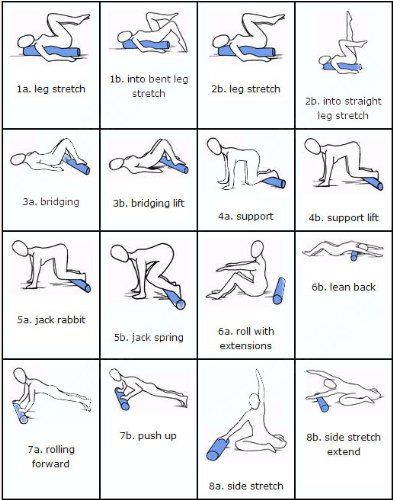But does everyone really know how many uses their foam roller has? This blog is to show you the three main categories of foam roller use, and a few examples of application!
Self Massage
I think this is the use that most people are familiar with: The 'hurts so good' rolling out of tight or bunched up muscles to get relieve without having to go to the therapist.
Rolling 'knots' or trigger points in your muscles can be very therapeutic, and can help you feel good after a long workout, assist with your stretching routine, and sometimes speed recovery from injuries.
The great thing about rolling as a self massage technique is that you control the pressure, duration and intensity of the session! There are a few ground rules though:
- Rolling should not bruise your skin! If it does, talk to your therapist to make sure you're doing it right. If you need that much pressure to feel like it's working, you might need some treatment
- Start slow and increase over time! The first time you roll, don't do 10 body parts for 3 minutes each! Maybe start with 30 seconds per part, and start with 2-3 key areas. If you get a good response, increase a bit day by day.
- Never roll completely cold! Either heat up with a bit of mild exercise (10-15 minutes walking, jogging or biking), or externally with a hot shower (I like the exercise option better! Gets a deeper heat).
- You control the pressure! If something is too intense, shift your weight off the roller and onto your supporting limb. Start by rolling out one limb at a time, and add in the partner next time!
Here's some ideas of how to roll different parts to get you started;

Joint Mobilization
One major technique that therapists use in the clinic is using gentle and controlled force to mobilize a joint. The principal is to hold one part of the joint stable (i.e. the shin bone) and mobilize the other part against it (i.e. the femur).
This principal can be applied as part of a home program, by using the foam roller to stabilize one part, and body movements to mobilize the other part. I commonly prescribe techniques for upper back or shoulder mobilization.
This is a bit more tricky to teach yourself though, and while it's a great home program exercise, it needs to be coached extensively before going solo! If you think foam roller mobilization would work well with your home program, ask your therapist at your next treatment!
Exercise Equipment
A foam roller isn't always just used as a recovery tool, but can also often be used as a prop to intensify exercises! Check out these options and see if they fit into your routine. You can make up your own as well, as long as you are careful, ease into it, and have a spotter if you're trying something risky!

Where can I get my own foam roller?
Usually you can get a foam roller at fitness, sports equipment, or running stores. What you're looking for is the right length (long if you're using it for a lot of exercises, short if you need something to travel to the field with you!), and that it is very firm!
If you're in the Guelph area, give me a shout, and I can hook you up with a great roller at a great price!
